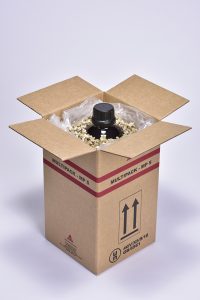Recognizing the need for safe transportation
Hazardous goods span many industries and sectors all over the world comprising many different roles, areas of specialty and unique knowledge. There are various sets of regulations governing the transport of hazardous goods which overall can make shipping hazardous goods a complex proposition.
Back in 1953 the International Air Transport Association (IATA) recognized the growing need to transport by air articles and substances that contained hazardous properties and if uncontrolled, could adversely affect the safety of passengers, crew and potentially the aircraft moving those goods.
They set out a general philosophy which can be found in the introduction of the IATA hazardous goods regulations. Within this philosophy they state:
‘Packaging is an essential component in the safe transport of hazardous goods by air.’
‘Training is also an essential element in maintaining a safe regulatory regime. It is necessary for all individuals involved in the preparation or transport of hazardous goods to be properly trained to carry out their responsibilities.’
There is no doubt that since 1953 the world is a safer place as a result of the various governing transport regulations but how safe and are the means of measuring safety by recording incidents giving us a true sense of the picture?
The Good, the Bad and those in between
Those of you reading this article and the vast majority of those requesting regulated packaging have good intentions and want to be compliant, the good guys. However, when you look at the world through the eyes of a packaging manufacturer providing advice and support on regulated packaging, it becomes clear that not everyone understands how to select and use packaging compliantly.

At times it is clear that even those who have received training can get confused, with some requiring education on how packaging should be used preventing compliance issues before packaging is purchased. If we consider the amount of time during training that is spent on packaging selection and its correct use, a different picture on safety compliance becomes clear.
Take for example a Carriage of hazardous goods by Air Course in which over 3 days a complete novice, subject to passing an open book exam on day 3 can sign shipper’s declarations undertaking all the responsibilities of the shipper. Typically given the breadth of the subject matter and time permitted over 3 days the training on packaging will last not much longer than 1 – 2 hours.
There are of course those that prefer not to follow the regulations either through willful ignorance or purposeful avoidance of declaring hazardous goods, the bad guys. We cannot legislate too much without hurting the good guys, proportionality is key.
It is also not unimaginable to consider that even the good guys, with businesses that thrive on good practices may have various people involved in transporting hazardous goods, the buyer, packer, warehouse operation and logistics co-ordination, each likely to be dedicated and professional. However sometimes through the mire of an organization, roles and responsibilities become blurred and compliance can become vague, the, those in between.
The reality of incident reporting
Surely if the statistics from incidents and reported offences tell us something positive, we don’t have much of a problem, we can all sleep soundly and our work here is done, right? Wrong, the problem with any statistics is the ability to present a picture based on reliable data.
Within the USA, roadside vehicle stops are routinely carried out and statistics are likely to show out of date fire extinguishers being one of the top offences, whereas packaging compliance related offences are virtually none. But if we are not asking the questions, literally inspecting the packaging and checking it’s compliant we cannot collect data and as a result a colourful pie chart may present a slightly skewed reality.
Yes, yes, it would be virtually impossible to do and given most government agency budgets being stretched ever more and with constant pressures on hauliers in a low margin industry it would be too onerous and disruptive based on actual incidents, once again proportionality is perhaps key.
The balancing act
It goes without saying that in our current climate Government decision makers around the world have to use proportionality when balancing the safety and wellbeing of the public without damaging the economy and the impact restrictions could have in the long term, we can all probably agree that this is not straightforward. Nor is then the methods in which we control the movement of hazardous goods but we do have legal frameworks, defined training and packaging approval schemes so we are in a good situation but could this be improved, yes it could.
At present we have to rely heavily on good faith that people will do the right thing even though there will be those that want to bend or break the rules, enforcement will not be the sole answer so education and responsibility must improve.

If we consider responsibility in transporting hazardous goods, this should be improved so that before goods move, carriers insist on more than a signed shippers declaration or transport document, known shipper \ verified shipper schemes already exist but could this become a wider initiative? Hazardous Goods Safety Advisors (DGSA’s) have a great role and are extremely effective but they do not reach every business and are not always required based on quantity limits or that the movement of hazardous goods are not the primary part of a business, even more need in this case for support.
Education can be delivered in many different ways but for too long and too often we have relied on common sense prevailing. We hear this all the time, a lot of people have it and a lot of people appear not to have it and yet somehow, we hope people will apply it but what exactly is it?
Common sense v competence
Common sense has been quoted as being the faculty of self-evident truths. In a nutshell you gain experience from the environment and people around you without the aid of proper training and qualification. So, if we are moving Auntie Dot’s three-piece-suite and dining table, we are most likely going to apply some of this common sense, we may wrap some blankets around it and even strap it down so it doesn’t move around and break itself or something next to it.
What if it does move and break, will Auntie Dot be unhappy, probably, will anyone or the environment be any worse off, probably not. But what if we are moving hazardous goods and we apply some of this common sense. We need to ship some nasty corrosive and decide to put this in a bottle and place the bottle in a box with some cushioning, tape it up, label it and ship it. What if during its journey it gets dropped and perhaps there was not enough of or the wrong cushioning inside the box, will it break and leak out, possibly, will anyone or the environment be worse off, very possibly, will a lot of people be unhappy, yes.
In some cases, common sense is best avoided due to the fact that one person’s common sense could be hugely different form another’s. Anyone who has either been in a trade-based role, learning on the job alongside mentors coupled with practical examinations or indeed within the armed forces will have adequate understanding of competency-based training. The idea is that things can only be put together in a specific way or direction not in a way you think it should or would like to.
Competency based training is soon to be introduced in hazardous goods training, it may not change things overnight and there are already great trainers out there doing great work but it will take us in a direction to improve and record the competence of individuals.
Collective responsibility
So why do we care and aren’t we just over egging the pudding somewhat? Well in spite a lack of incidents being reported it comes down to a collective responsibility to act. Hazardous good packaging is not overly complicated we just need to use it in the way in which it has been approved, if not, we may end up with an incident that could have been avoided for which there is no real way of calculating the impact that may cause.
Manufacturers should do their bit and provide the necessary support and advice including assembly instructions, so too, must the trainers improve the education, the consultants review the competencies and the enforcement agencies be prepared to ask some more questions.
Air Sea Containers continue to educate and a link here will take you if interested to Stop Know Do which summarizes some of the above with a simple video, feel free to take a look and share it with those you think will benefit.
If you would like any advice when choosing the correct hazmat packaging for your goods Air Sea Containers can help: Call 001 412 308 5888 |Email us@airseadg.com
 US
US

